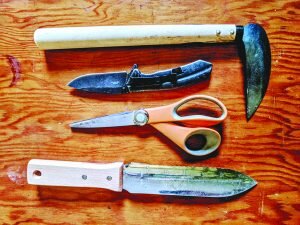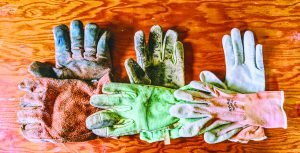
The darkness is lifting, living nature is rising to meet the sun and foragers are itching to get out into the sunlight. Whether it’s their first or 500th time finding plants, smart foragers are always looking for more effective tools for the job.
Foraging is varied work. At times, you know what you’re collecting and where it is. Other times, you have a desire to be outside to see what you’ll find. Whether a particular berry is ripe and ready to pick or if a favorite mushroom is poking above the duff – we foragers can never be sure.
If you’re after something specific, it’s easy to bring only the tools you need. But if you are out to see what you can find, your pack needs more variety. These are my must-haves.
The essentials
I always have a daypack with a snack, sunscreen, hat, basic first aid kit and a water bottle. If I’m out hiking or wandering, these things, paired with a charged cell phone and smart, versatile clothing, can make huge a difference in survival and safety.
Containers
A container with a rigid opening and a handle is your most reliable tool. I like side straps on small buckets for berries, woven baskets with sturdy bases and handles for gathering ground plants and fungi, and a side belt bag for walking. Think about what will work well with your body and what you’re harvesting. If it’s something heavy, wet, or fragile, having a wider container will prevent your bounty from stacking up and squishing each other. Are you foraging something of unusual size or shape? Consider what bags will keep it contained.
Mesh produce bags are convenient for separating plants within the same container, and I bring along dishcloths to pad plants or provide them with shade. I also wrap damp cloths around plants to keep them from wilting. It is important to preserve your harvest between the field and your home.
Harvesting tools
Most foragers I know have a wide variety of tools to choose from when harvesting. Personally, I rely on a folding pocketknife, kitchen scissors, a hori hori (or weeding knife) and pruning shears. In the realm of specialty tools, I have a small scythe that has been invaluable in harvesting nettles the last few years, a large digging fork for loosening deep roots, an apple picker tool for reaching high up fruits and branches, and a flathead screwdriver to harvest pitch from trees. I recommend tools with sturdy handles, scissors and shears that spring open and cut cleanly, and a pocketknife with a three-inch blade.
Clothing
The clothes worn while foraging can change your life. Sturdy, waterproof shoes, warm layers, a good rain jacket, protective pants and the right gloves are the VIPs on my list. I probably have 20 pairs of gloves, but I use three the most: a pair of thick leather gloves for harvesting spiky plants or with heavy duty tools, a set of gardening gloves with a leather palm and a strong canvas back for digging and picking sticky cottonwood buds, and a thinner pair of gloves with a rubberized palm and breathable back for berry picking and more detail-oriented work.
I generally wear Carhartt pants or overalls because they are loose enough for easy movement and have double front leg panels for protection from thorns, vines and stinging things. If there’s a chance of rain, I stuff a rain shell in my bag, and choose breathable layers to maintain my comfort. The ever ubiquitous Xtratuf rain boots are perfect for harvesting in wet areas, and I recommend wearing terrain-appropriate shoes at all times. 
Overall, you don’t need anything more than a sack and positive plant ID to find plants for food or medicine. Tools are just around to make life easier and more efficient. Find what works for you, keep your sense of curiosity, and get out foraging!
Amy Gibson loves learning about all the edible and medicinal plants she can find in Whatcom County.